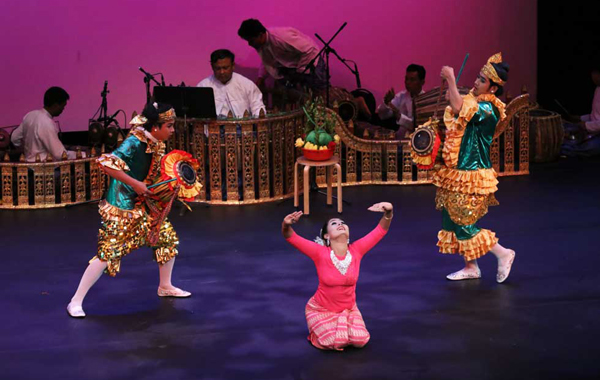Arts
The art of Myanmar Zat-pwe
- Details
- Hits: 7224
 The art of Myanmar Zat-pwe
The art of Myanmar Zat-pwe
Photo Credit - www.artsinitiative.columbia.edu
The meanings
In Myanmar. zat means story and pwe means show. so finally zat-pwe means Myanmar musical play. It can be understood as the opera or ballet of the western countries.
The characters
The characters included in the Zat-pwe are mintha. male lead; minthami. female lead.
Included events
Ngo-gyin means wailing song. nha-par-thwar means duet dance and song. lun-khan means tragic scene.
All about the Zat-pwe
There is no nation on the face of the earth so fond of fun and laughter and theatrical entertainment as the Myanmar. Without the benefit of Saing (Myanmar Orchestra) is a popular Myanmar idiom to describe any dull. uninteresting event or something unceremonious or unheralded. A person arriving without any previous notice is often remarked upon as arriving without the benefit of Saing.
The art of Myanmar Zat-pwe is one of the subtlest and most elusive of arts and trying to explain it is like capturing a moon beam to analyze its power over lovers and poets.
Zat-pwe is deeply rooted in the traditions of the country and has many conventions which are not easily understood by a casual spectator. Myanmar's monarchical pass has given the Zat-pwe the glorious music and songs as well as court dramas of great poetic beauty. Most of the Zats (stories or plots) are drawn from Buddhist scriptures and from there. the Zat artistes draw their inspiration and help to interpret to the laymen the Buddhist thought the way of life.
Since the elements of the opera. ballet and musical are woven into the zat-pwe. the whole thing is a wonderful piece created by the teamwork of artistes; but the artistes themselves are fiercely individualistic. each expressing himself or herself with such freedom that it makes you marvel at the spontaneous coordination that is finally achieved.
Today. zat-pwe is still misinterpreted and much injustice is being done to it in futile attempts to evict decadent influences that are as natural as weeds in a flower garden. One cannot be too careful not to injure the blooms in pruning away the undesirable under-growths.
Nha-par-thwar scene in the old days used to be a duet. dancing and singing. with one mintha and one minthami. Later. probably to meet the demands of the audience. the artistes introduced new attractions. hence one mintha with many minthamis in the scene.
The dancing and singing of each minthami in nha-par-thwar scene symbolize different facets of feminine charm and the mintha responds with varying moods to match each act. One of the arts of'a mintha is part of nha-par-thwar. not only has he to do the duet dance and sing. he must also have subtle artistry in reciprocating the infinite variety of his minthamis.
The nha-par-thwar scene in the hands of a consummate artist blossoms forth as a thing of beauty. but when a lesser performer enacts it. it becomes nothing but a vulgar sham. a Cassanova shamelessly flaunting his amours and bringing out the worst side of man's baser instincts.
Suffice it to say for the present that the art of ngo-gyin. like that of nha-par-thwar. needs a really accomplished artist to bring out its beauties.
Zat-pwe is thoroughly Myanmar. very much in keeping with the national character. and I hope I shall ever be Myanmar enough to enjoy its beauties that custom cannot stale. I hope I shall never be such a dull piece of goods. that the stirring music of nat-chin. the music of the nat-ka-daw dance which usually opens a zat-pwe fails to make my heart beat to its tune. I pray that I may never have a soul so dead that the dance of the belus. zawgyis. and nagas fails to fill me with a sences of wonder and insight into human aspirations symbolized by these mythical creatures.
The people of the Zat-pwe
U Shwe Mann Tin Maung was a well-known performer of the Zat-pwe. He was awarded with the "A Lin Gar Kyaw Swa" award for being the best and the most talented performer for the theatre arts. He was the first and the only one to ever get this honorary award. He established the "Thitsar Myitar Shwe Mann Thabin". He taught his skills. knowledge and talents to his five sons who inherited his troupe after his death. His sons were Nyunt Win. Win Bo. Win Maung. San Win and Chan Thar. Among the five sons. only Chan Thar became to take his father's place as a great performer. He has his shows all over the country. The third generation of Shwe Mann is "Tin Maung San Min Win". the son of San Win. Now. he and his uncle "Chan Thar" together make marvellous shows in Myanmar and in other countries. The young artist started his courier at the age of 15. He is not only talented at such a young age. he is the third generation artist carrying on the Shwe Mann legacy. Tin Maung San Min Win has won the National Cultural Dance competition in Myanmar. after receiving top awards in every division he participated in.
Some other troupes are Moe Win & Moe Min group. Nan Win group. Pho Chit group and some more. Although there are more troupes of the Zat-pwe performance. Shwe Mann Tin Maung Troupe is the most popular group among them.



